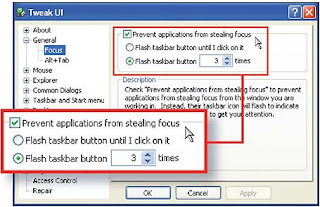So there you are, minding your own business, typing a document, e-mail, or instant message on your computer. You glance away from the screen for a moment. When you look back, you realize you haven't really entered your last lines of text. Without your knowledge, a new window or dialog box has popped up, and some of your text has been entered there--or nowhere. Applications that steal your PC's focus are more than just annoying: They can be disastrous if the focus-stealing dialog box asks to perform a potentially harmful operation and you happen to press [Enter] or type [Y], which the dialog takes as a "Yes" before you even see the request. You may also have dismissed an important scheduling alert without realizing it.
No solution exists, but the following may help you maintain your focus in Windows XP and 2000 by Microsoft's free Tweak UI.
Open Tweak UI by typing tweakui on Run, and press [Enter] and use the tree pane on the left to navigate to General, Focus. Make sure "Prevent applications from stealing focus" is checked. You can also specify whether the taskbar button should flash and how many times when the would-be focus grabber wants your attention. Click OK.

Some Tweak UI settings get changed back when a program subsequently modifies the Windows Registry. To make sure the focus lock is in effect every time you start Windows, start Notepad or another text editor.
1. On the first line, type "Windows Registry Editor Version 5.00" and press [Enter] twice.
2. Type "[HKEY_CURRENT_USER\Control Panel\Desktop]" and press [Enter].
3. Finally, type "ForegroundLockTimeout"=dword:00030d40 and press [Enter].
4. Save name the file with the .reg extension like focus.reg), and place it to a location of your choice. Make a note of the path to the file.
5. Next, choose Start, All Programs, right-click the Startup menu, and choose Open.
6. In an empty area of the Startup folder, right-click and choose New, Shortcut.
7. In the Create Shortcut wizard, browse to your .reg file, select it, and click OK.
8. Place quotes before and after the entry, and then press [Home].
9. Type "regedit.exe /s" followed by a space in front of the first quotation mark in your entry.
10. When completed, the entry should read something like this: regedit.exe /s "C:\Registry files\focus.reg" (your path may differ).
11. Click Next, type a name for your shortcut, and click Finish. Now every time you log on, this shortcut will reinstate the anti-focus-stealing setting.
2. Type "[HKEY_CURRENT_USER\Control Panel\Desktop]" and press [Enter].
3. Finally, type "ForegroundLockTimeout"=dword:00030d40 and press [Enter].
4. Save name the file with the .reg extension like focus.reg), and place it to a location of your choice. Make a note of the path to the file.
5. Next, choose Start, All Programs, right-click the Startup menu, and choose Open.
6. In an empty area of the Startup folder, right-click and choose New, Shortcut.
7. In the Create Shortcut wizard, browse to your .reg file, select it, and click OK.
8. Place quotes before and after the entry, and then press [Home].
9. Type "regedit.exe /s" followed by a space in front of the first quotation mark in your entry.
10. When completed, the entry should read something like this: regedit.exe /s "C:\Registry files\focus.reg" (your path may differ).
11. Click Next, type a name for your shortcut, and click Finish. Now every time you log on, this shortcut will reinstate the anti-focus-stealing setting.
You're all set! Continue on what you are doing.

1 comment:
Changing a processors priority to "High" is usually safe but do so only to solve specific problems, not to improve it's performance. Windows does not really assign CPU time according to priority. Do not be tempted to set the priority to "Realtime". Some critical system processes run at a priority lower than this and they could be completely starved of CPU time. This could cause a lockup reguiring a reboot to recover.
Larry Miller
Microsoft MCSA
Post a Comment